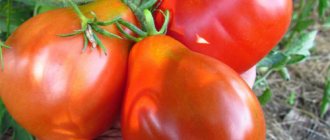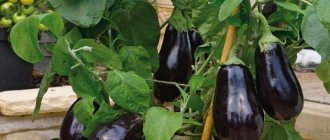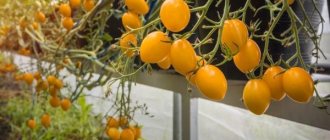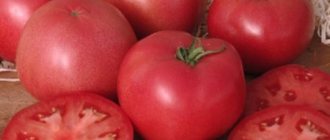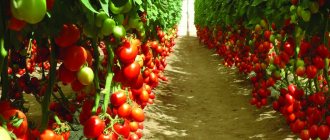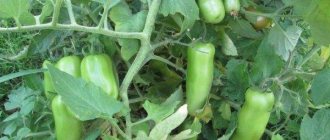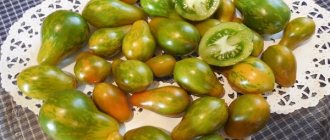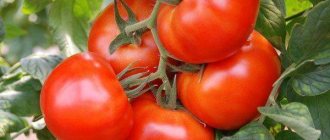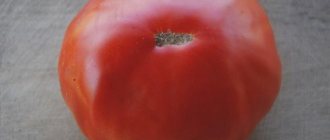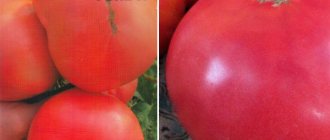» Vegetable growing » Tomatoes » Tomato variety Japanese dwarf
0
1146
Article rating
The Japanese dwarf tomato is a compact variety that can be grown not only in the garden, but also in a flower pot. The plant is unpretentious and rarely gets sick, calmly tolerates lighting restrictions, and is content with a small area of land. To get a good harvest, it is useful to know the characteristics of this variety and the rules of agricultural technology.
- Advantages and disadvantages
- Landing
- Transfer
- Care
- Gardeners' opinions
Tomato variety Japanese dwarf
Description and characteristics of the variety
The Japanese dwarf belongs to the category of undersized determinants. It grows in miniature bushes that do not exceed 50 cm in height. Plus, there is no need for pinching, although fixation to support clusters with fruits is desirable.
The tomato is adapted to indoor conditions and tolerates well:
- lack of lighting;
- small spaces.
Cultivation is actively carried out in open soil and in protected beds. The variety was created for areas with risky farming. Adapted to the weather of northern summer (temperature fluctuations, heavy dew). Planting takes place in the following areas:
- Siberia;
- Ural;
- Altai;
- Far East.
Fruiting begins at the end of June and lasts until autumn. The timing of the first harvest is 90–95 days after germination.
The variety is characterized by the following characteristics:
- superdeterministic growth;
- many stepchildren;
- precocity.
Tomatoes are medium in size and the fruits are used in fresh dishes. Suitable for canning and preparations in the form of juices, pastes, ketchups.
Description of fruits:
- average weight - 150–200 g;
- large specimens weigh 300–400 g;
- shape - round;
- coloring - bright red;
- the skin is strong, shiny;
- the taste is balanced.
Japanese dwarf tomato variety on video
If you have grown Japanese dwarf tomatoes, please write how you rate this variety. What was the yield and taste of the fruits like under your climatic conditions? Briefly describe the advantages and disadvantages of this tomato in your opinion. How do you rate the disease resistance of this variety?
Your reviews of the Japanese dwarf tomato and additions to the description will help many gardeners evaluate this variety objectively and decide whether it is worth planting or not.
This is a natural variety of tomato. Therefore, we recommend taking seeds from a ripe fruit and using them for planting in subsequent seasons.
A website about tomatoes is always at your service - Tomatland.
Advantages and disadvantages
Pros:
- precocity;
- adaptation to weather conditions of northern latitudes;
- drought resistance;
- extended fruiting period;
- massive productivity;
- resistance to gusty winds;
- tolerance to unstable weather conditions;
- endurance to temperature changes;
- strong immunity to a range of infections;
- unpretentiousness of care.
Minuses:
- the importance of fertilizing;
- the need to fix the stems.
Mongolian dwarf
In addition to the Japanese dwarf, vegetable growers have fallen in love with the Mongolian dwarf tomato variety. Its name is similar, but its characteristics have its own characteristics.
Plant dimensions
The Mongolian dwarf has an unusual bush structure. First, the main shoot stretches upward, reaches a small height of 15 - 30 cm, and then bends sideways and bends towards the ground. The bush grows with short shoots, spreading out in all directions. It can occupy an area from half a meter to a meter in diameter.
Mongolian dwarf is rightfully considered a super-determinate variety. The root system is superficial, branches not in depth, but in breadth. At first, young plants develop very slowly, then growth accelerates. Spreading shoots do not need garter, and there is no need to pin them down either.
Fruit
Such dwarf bushes produce unexpectedly large fruits, weighing about 200 grams. The average weight is also quite respectable - 170 grams. The tomatoes are round, raspberry-red. Taste is greatly influenced by weather conditions. Sometimes the pulp is a little sour, but quite pleasant, with a typical “tomato” aroma.
The fruit density is quite high. The tomatoes are fleshy, with a small amount of liquid, and transportable. The skin is dense, but can still be damaged by slugs, because the weighty brushes practically lie on the ground. When growing a Mongolian dwarf, it is necessary to lay a layer of mulch (straw, hay, agrofibre) under it.
The Mongolian dwarf variety is early ripening. The fruits begin to ripen very early, sometimes as early as late June - early July. Almost the entire crop turns red on the vine, even in the open ground of the Moscow region and Siberia. The bushes branch and constantly grow new ovaries. Fruiting lasts a long time, until frost. Mongolian dwarf tomatoes are tolerant of cold weather and drought, and resistant to bacterial and fungal infections.
Mongolian dwarf tomatoes are not yet sold in stores. The variety has no official status. Amateur gardeners share the seeds with each other. At first, this tomato was distributed in Transbaikalia and Siberia, and now it is grown by gardeners throughout Russia.
Gardeners always give their preference to varietal early-ripening tomatoes, which is exactly what the Japanese dwarf tomato is. It was bred by Kazakh breeders and officially goes on sale from Kazakh agro. But since this species is not a hybrid, it is quite possible to collect seeds from it, which is what gardeners do. You can also purchase seed directly from such hobbyists.
The Japanese dwarf tomato variety is attractive because it ripens quite quickly and has high productivity. Breeders characterize it as an unpretentious type of tomato. Although experienced vegetable growers often point out some features of growing and caring for it.
In order to get a good harvest, you need to carefully study all the advantages of the Japanese dwarf tomato.
Landing
Seeds are sown for seedlings from mid-March. In the southern regions, planting in beds is possible (seedless technique). To reject and sort seed material, soaking in a saline solution is used. Potassium permanganate and Fitosporin are used for disinfection.
To speed up germination, activators are used:
- Epin;
- Agate;
- Zircon.
The containers used for planting are boxes, pots, glasses, and peat tablets. The soil is prepared purchased or turf is taken, to which compost and peat are added.
How to plant seeds correctly:
- The containers are filled with soil and drainage is placed at the bottom.
- Form grooves 1.5 cm deep, the step between the grooves is 4 cm.
- The seeds are placed at a distance of 1–2 cm.
- Sprinkle with a fine mixture.
- Wrap the containers with film.
- Keep until germination at a temperature of 25–27 degrees.
The seedlings are additionally illuminated with phytolights. Watering is done with a spray bottle. Picking is needed when 1–2 leaves appear on the seedlings. Fertilizers are applied 2 times (nitrogen compounds are used). Hardening is carried out 8–10 days before transplantation:
- The containers are placed on the loggia at 14–15 degrees.
- The hardening time is extended from 2 to 10 hours.
Bushes with 7-8 leaves are planted in a permanent place.
Features of cultivating Japanese dwarf at home and in the garden
Japanese dwarf is rarely planted in greenhouses . They are resistant to temperature changes and are able to grow in open ground even in northern regions.
When growing tomatoes in open ground , for the first 2 weeks after picking, they are covered with film in the evening so that they do not die during night frosts.
In pots on the balcony, the method of growing tomatoes is no different from cultivating them in open ground. The lack of lighting must be compensated with fluorescent lamps.
Growing and care
For 1 sq. m, 4 bushes are planted. The holes are placed at a distance of 60–80 cm.
Humus, superphosphate, and compost are added to the holes. The roots and lower part of the stem are sprinkled and watered abundantly. The next moistening is carried out after 7–8 days.
During the growing season and fruiting, the following is carried out:
- moisturize 2-3 times a week;
- formation once per season (pluck out the stepsons below the flower cluster);
- removing growth at the base of the stem;
- fertilizing 2 times a month (organics and minerals).
Seed preparation
Most gardeners purchase Japanese dwarf seeds from their fellow hobbyists. Such planting material must be checked for germination. To do this, soak it for half an hour in a glass of water with the addition of 1 teaspoon of salt. Floated specimens are collected and thrown away. The seeds that have sunk to the bottom are washed and used for planting.
Planting material must be disinfected. To do this, it is soaked for 20 minutes in hydrogen peroxide or a light pink solution of potassium permanganate.
Another option is soaking in a growth stimulant. Use “Sodium Humate”, “Epin” or “Zircon”. As folk remedies that accelerate the germination of planting material, use water with honey, soda solution or aloe juice.
Preparation of soil mixture and selection of containers
For tomato seedlings, choose light but nutritious soil. Suitable compositions are sold in specialized stores, but most gardeners prefer to prepare the soil themselves.
There are many ways to prepare soil for tomatoes. The list contains several good options:
- Equal parts of black soil and peat are mixed. Add 0.5 parts of humus and 1 part of river sand to the resulting composition. Take 10 g of ammonium nitrate and potassium chloride per bucket of the resulting mixture.
- For 3 kg of peat, take 1 kg of sawdust, 0.5 kg of mullein and 1.5 kg of river sand. For this amount of soil mixture, take 5 g of ammonium nitrate and potassium chloride, as well as 10 g of superphosphate.
- Peat, humus, garden soil and sawdust are mixed in equal proportions. For a bucket of mixture take 1.5 tbsp of ash, 1 tbsp. l potassium sulfate, 3 tbsp. l superphosphate and 1 tsp urea.
The soil for tomatoes needs to be disinfected. To do this, it is calcined in the oven or poured with a dark pink solution of potassium permanganate.
To sow seeds, take large shallow containers. They use both special trays, cassettes and boxes, as well as improvised means.
For picking plants, use any deep containers with a volume of at least 300 ml. Drainage holes are made at the bottom of homemade pots.
All dishes for sowing seeds are disinfected - soaked in a dark pink solution of potassium permanganate.
Sowing seeds
Japanese dwarf is an inexpensive and unpretentious variety. More often it is grown by sowing seeds in one large container and then planting them in individual pots.
Soil is poured into the seedling box. The soil is watered abundantly and leveled. Make grooves 1 cm deep at a distance of 2-3 cm from each other. Seeds are placed in them at intervals of 2 cm.
The seeds are covered with soil. The containers are covered with film and placed in a warm place with a temperature of 24-26 ºC.
Rules for caring for seedlings
Growing tomato seedlings is not difficult. You just need to follow the basic rules for caring for it:
- When the first shoots appear, the film is removed from the boxes. They are moved to a well-lit place. Experienced gardeners recommend that after seed germination, place the seedlings in a room with a temperature of 17 ºC for a week. The plants are then placed in a warm place. This will prevent the tomatoes from pulling out prematurely.
- Water the tomatoes with warm water. Water should not fall on the above-ground part of the plant. The frequency of watering depends on the rate of drying of the soil.
- When real (not cotyledon) leaves appear, the tomatoes are dived into separate pots. A layer of drainage is placed at the bottom of the containers. There is no need to pinch the roots of the plants.
- It is fed 3 times during the period of growing seedlings. The first time 2 weeks after picking into individual containers, the second time 14 days after the previous feeding, the last time 5 days before planting tomatoes in open ground. Use complex fertilizers or vermicompost.
- Hardening off tomatoes will allow them to quickly adapt to open ground conditions. To do this, the seedlings are taken outside every day for several hours. The procedure begins 2 weeks before planting the tomatoes in a permanent place.
